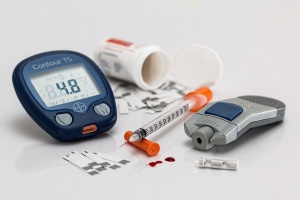Pharmacological Management of Diabetes Mellitus: Difference between revisions
(Addition of content and references) |
No edit summary |
||
| (18 intermediate revisions by 4 users not shown) | |||
| Line 1: | Line 1: | ||
== | <div class="editorbox"> '''Original Editor '''- [[User:Ashton Randolph|Ashton Randolph]] '''Top Contributors''' - {{Special:Contributors/{{FULLPAGENAME}}}}</div> | ||
Diabetes | == Introduction == | ||
[[File:Diabetes-528678 960 720.jpg|right|frameless]] | |||
[[File:Human insulin 100 IU-1ml pen yellow background.jpeg|thumb|Insulin pen]] | |||
[[Diabetes]] (a chronic disease) can be managed effectively with lifestyle modifications (eg weight reduction, diet and exercise) and use of pharmacological agents.<ref>Ngugi MP, Njagi JM, Kibiti CM, Miriti PM. [https://www.researchgate.net/publication/270282424_Pharmacological_Management_of_Diabetes_Mellitus Pharmacological Managemen t of Diabetes Mellitus.] Asian Journal of Biochemical and Pharmaceutical Research. 2012;2:375-81. Available:https://www.researchgate.net/publication/270282424_Pharmacological_Management_of_Diabetes_Mellitus (accessed 22.1.2023)</ref> | |||
Having an understanding of these medicines will allow physical therapists to identify medical emergencies, manage treatment sessions, educate patients, and refer to the proper healthcare provider when warranted. | |||
== | == Commonly Used Medications == | ||
# [[Insulin]] is a hormone made by beta cells in the pancreas. When we eat, insulin is released into the blood stream where it helps to move glucose from the food we have eaten into cells to be used as energy. With [[Diabetes Mellitus Type 1|type 1 diabetes]], the body produces little or no insulin as the cells that produce insulin have been destroyed by an autoimmune reaction in the body. Insulin replacement by daily injections is required. With [[Diabetes Mellitus Type 2|type 2 diabetes]] the body produces insulin but the insulin does not work as well as it should (referred to as insulin resistance). To compensate the body makes more but eventually cannot make enough to keep the balance right. Lifestyle changes can delay the need for tablets and/or insulin to stabilise blood glucose levels. When insulin is required, it is important to understand that this is just the natural progression of the condition.<ref>Diabetes Australia [https://www.diabetesaustralia.com.au/ Insulin] Available: https://www.diabetesaustralia.com.au/<nowiki/>/(accessed 25.1.2023)</ref> | |||
# [[Pramlintide in the Treatment of Diabetes Mellitus|Pramlintide]] a synthetic amylin analog that is an injectable drug used with insulin to reduce blood sugar levels in patients with type 1 and type 2 diabetes.<ref>[https://www.merriam-webster.com/medical/pramlintide “Pramlintide.”] ''Merriam-Webster.com Medical Dictionary'', Merriam-Webster, https://www.merriam-webster.com/medical/pramlintide. Accessed 24 Jan. 2023.</ref> | |||
# [[Metformin]] is used together alongside diet to lower high blood sugar levels in patients with type 2 diabetes. Metformin has various actions, being, lowers the amount of glucose absorbed from intestines, decreases how much glucose is made in the liver and improves insulin sensitivity.<ref>Drugs.com [https://www.drugs.com/metformin.html Metformin] Available:https://www.drugs.com/metformin.html (accessed 25.1.2023)</ref> | |||
# [[Sulfonylureas in the Treatment of Diabetes Mellitus|Sulfonylureas]] are a type of medicine used in the management of Type 2 diabetes. They work by stimulating beta cells of the pancreas to produce insulin hence lowering blood glucose levels. Their action is needs person to have functioning Beta cells, therefore, only work in people with type 2 diabetes.<ref>Drugs.com [https://www.drugs.com/drug-class/sulfonylureas.html Sulfonylureas] Available:https://www.drugs.com/drug-class/sulfonylureas.html (accessed 25.1.2023)</ref> | |||
== [[ | == Conclusion == | ||
Physical therapist need to be aware of the intended effects, as well as possible side effects of medications for diabetes, eg [[hypoglycemia]] and [[ketoacidosis]], that may be prevalent with certain medications. | |||
* Maintaining proper glucose levels can prevent sequelae of the disease, and can also impact the treatment session. | |||
* Physical therapists are in a unique position because of the amount of time we spend with patients, and it is imperative that we play a role in monitoring their well-being. | |||
== [[ | == References == | ||
<references /> | |||
[[Category:Winston-Salem State University Pharmacology Project]] | |||
[[Category:Pharmacology]] | |||
[[Category:Interventions]] | |||
[[Category:Diabetes]] | |||
Latest revision as of 02:26, 25 January 2023
Introduction[edit | edit source]
Diabetes (a chronic disease) can be managed effectively with lifestyle modifications (eg weight reduction, diet and exercise) and use of pharmacological agents.[1]
Having an understanding of these medicines will allow physical therapists to identify medical emergencies, manage treatment sessions, educate patients, and refer to the proper healthcare provider when warranted.
Commonly Used Medications[edit | edit source]
- Insulin is a hormone made by beta cells in the pancreas. When we eat, insulin is released into the blood stream where it helps to move glucose from the food we have eaten into cells to be used as energy. With type 1 diabetes, the body produces little or no insulin as the cells that produce insulin have been destroyed by an autoimmune reaction in the body. Insulin replacement by daily injections is required. With type 2 diabetes the body produces insulin but the insulin does not work as well as it should (referred to as insulin resistance). To compensate the body makes more but eventually cannot make enough to keep the balance right. Lifestyle changes can delay the need for tablets and/or insulin to stabilise blood glucose levels. When insulin is required, it is important to understand that this is just the natural progression of the condition.[2]
- Pramlintide a synthetic amylin analog that is an injectable drug used with insulin to reduce blood sugar levels in patients with type 1 and type 2 diabetes.[3]
- Metformin is used together alongside diet to lower high blood sugar levels in patients with type 2 diabetes. Metformin has various actions, being, lowers the amount of glucose absorbed from intestines, decreases how much glucose is made in the liver and improves insulin sensitivity.[4]
- Sulfonylureas are a type of medicine used in the management of Type 2 diabetes. They work by stimulating beta cells of the pancreas to produce insulin hence lowering blood glucose levels. Their action is needs person to have functioning Beta cells, therefore, only work in people with type 2 diabetes.[5]
Conclusion[edit | edit source]
Physical therapist need to be aware of the intended effects, as well as possible side effects of medications for diabetes, eg hypoglycemia and ketoacidosis, that may be prevalent with certain medications.
- Maintaining proper glucose levels can prevent sequelae of the disease, and can also impact the treatment session.
- Physical therapists are in a unique position because of the amount of time we spend with patients, and it is imperative that we play a role in monitoring their well-being.
References[edit | edit source]
- ↑ Ngugi MP, Njagi JM, Kibiti CM, Miriti PM. Pharmacological Managemen t of Diabetes Mellitus. Asian Journal of Biochemical and Pharmaceutical Research. 2012;2:375-81. Available:https://www.researchgate.net/publication/270282424_Pharmacological_Management_of_Diabetes_Mellitus (accessed 22.1.2023)
- ↑ Diabetes Australia Insulin Available: https://www.diabetesaustralia.com.au//(accessed 25.1.2023)
- ↑ “Pramlintide.” Merriam-Webster.com Medical Dictionary, Merriam-Webster, https://www.merriam-webster.com/medical/pramlintide. Accessed 24 Jan. 2023.
- ↑ Drugs.com Metformin Available:https://www.drugs.com/metformin.html (accessed 25.1.2023)
- ↑ Drugs.com Sulfonylureas Available:https://www.drugs.com/drug-class/sulfonylureas.html (accessed 25.1.2023)








